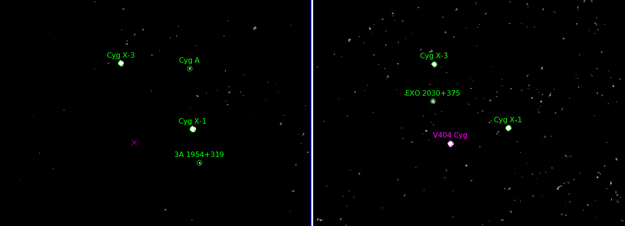On June 15th 2015, V404 Cygni, a system comprising a black hole and a star orbiting one another, made its comeback. In this type of binary system, material flows from the star towards the black hole and gathers in a disc, where it is heated up, shining brightly at optical, ultraviolet and X-ray wavelengths before spiraling into the black hole. First signs of renewed activity in V404 Cygni were spotted by the Burst Alert Telescope on NASA's Swift satellite, detecting a sudden burst of gamma rays, and then triggering observations with its X-ray telescope. Soon after, MAXI (Monitor of All-sky X-ray Image), part of the Japanese Experiment Module on the International Space Station, observed an X-ray flare from the same patch of the sky.

Credit: ESA
These first detections triggered a massive campaign of observations from ground-based telescopes and from space-based observatories, to monitor V404 Cygni at many different wavelengths across the electromagnetic spectrum. As part of this worldwide effort, ESA's Integral gamma-ray observatory started monitoring the out-bursting black hole on 17 June.
“The behaviour of this source is extraordinary at the moment, with repeated bright flashes of light on time scales shorter than an hour, something rarely seen in other black hole systems,” comments Erik Kuulkers, Integral project scientist at ESA. “In these moments, it becomes the brightest object in the X-ray sky – up to fifty times brighter than the Crab Nebula, normally one of the brightest sources in the high-energy sky.”
The V404 Cygni black hole system has not been this bright and active since 1989, when it was observed with the Japanese X-ray satellite Ginga and high-energy instruments on board the Mir space station.

Credit: ESA
“The community couldn't be more thrilled: many of us weren't yet professional astronomers back then, and the instruments and facilities available at the time can’t compare with the fleet of space telescopes and the vast network of ground-based observatories we can use today. It is definitely a 'once in a professional lifetime' opportunity,” adds Kuulkers.






Comments